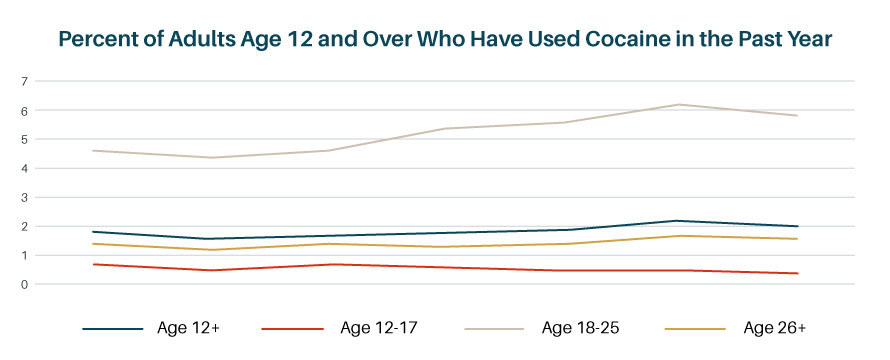Cocaine Addiction Treatment In Los Angeles
Use And Abuse Of Cocaine
Introduction
Cocaine is a stimulant and an addictive drug. Thus, cocaine addiction requires treatment at a rehab facility. Before attending cocaine addiction treatment, individuals should also make sure to attend cocaine detox. That way their cocaine withdrawal symptoms can be treated.
Many people that use cocaine increase their energy and stay awake. It’s one of many herbs, foods, drinks, and drugs that have been used and abused to “get up and go.”
While the thought of cocaine may bring about images of parties or crack houses, it has been used as a stimulant drug for thousands of years. This article will briefly review the history of cocaine, its modern-day use and abuse, misconceptions, and treatment options for addiction.
HISTORY
Cocaine is a substance that’s extracted from the Erythroxylon coca bush. This plant is native to western South America and is grown as a cash crop. The leaves from the coca bush have been used to increase energy, reduce fatigue, and reduce appetite since about 3000 BC.
Historically, South American natives would chew coca leaves to ingest the drug. The leaves were sometimes used in religious ceremonies or to counteract the effects of living at high altitudes. When the Spanish invaded Peru in 1532, they became acquainted with the effects of coca leaves and used them to keep their Incan slaves under control as they worked in the Spanish silver mines.
Early Medical Use
In 1859, a German chemist named Alfred Niemann was the first to extract cocaine from coca leaves. While not immediately popular in Europe, by the 1880s, the drug was used by the medical community to constrict blood vessels and limit bleeding, particularly during eye, nose, or throat surgeries.
Psychoanalyst Sigmund Freud also promoted the use of the drug to treat depression and sexual impotence. Freud was a regular user himself and recommended it to many of his patients.
During the 1880s and 1890s, cocaine was viewed as a “miracle” drug and was added to teas, tonics, elixirs, and the new soft drink Coca-Cola. Famous people of the era, including inventor Thomas Edison and actress Sarah Bernhardt, endorsed its benefits. It remained popular into the 20th century and enjoyed widespread use and promotion by Hollywood’s silent film industry.
Risks Come to Light
By the early 1900s, the adverse effects of cocaine had become more apparent to society. Coca-Cola removed cocaine from its formula in 1903 due to public pressure. Cocaine abuse drug doses continued to rise though. In fact, in the year 1912, the United States government reported 5,000 cocaine-related deaths.
In 1914, the United States passed the Harrison Narcotics Act, which made it illegal to sell or use coca and opium products except for medical purposes. It is still used legally today as a topical anesthetic for mucus membrane surgeries around and in the mouth, nose, and throat. Because of its continued use for medical procedures, cocaine is currently classified as a Schedule II drug under the U.S. Controlled Substance Act.
The Rise Of Cocaine Abuse
Until cocaine was banned by the federal government, people freely consumed it in the form of elixirs and tonics. In the early 1900s, people began snorting cocaine, leading to an increase in cases of nasal damage reported by hospitals and in medical journals. After cocaine was made illegal, recreational cocaine use and cocaine addiction rates dropped. This is because the same stimulant effects of cocaine became available in the 1930s through legal, pharmaceutical amphetamines.
Cocaine Use In The 1970s
Cocaine surged in popularity once again in the 1970s after legislation significantly restricted the availability of amphetamines. This substance was especially popular among wealthy business people, celebrities, and college students who were attracted by the ability of the drug to increase energy. Cocaine was expensive and was viewed as a “rich man’s drug,” but the street price dropped as it surged in popularity and production.
The Arrival Of Crack
In the 1980s, drug dealers who were looking for more ways to make money began pushing crack cocaine. Crack, given this nickname by the crackling sound it made during processing, was formulated in a way that allowed it to be smoked. By smoking crack cocaine, the substance gave people a shorter, more intense high. This process also made crack cocaine more addictive, thus increasing cocaine addiction and cocaine withdrawal rates.
Crack cocaine was cheaper to produce and sell. This led to a sharp increase in the use of cocaine, with the number of regular cocaine users jumping from 4.2 million to 5.8 million between 1985 and 1989. As a result, by the early 1990s, Colombian drug cartels were shipping 500 to 800 tons of cocaine per year to the United States, Europe, and Asia
The Effect Of The War On Drugs
While the “War on Drugs” of the 1980s and 1990s helped to disband the large cocaine drug cartels, many smaller organizations popped up to replace them. These smaller drug cartels are still operating in Colombia and act as the primary source of cocaine production today.
Cocaine use and thus, cocaine withdrawal and cocaine addiction in the United States decreased during the 2000s, reaching a low point in 2012. Between 2012 and 2017, cocaine smuggling and new cocaine users in the United States rose once again though, with 1.6 million new cocaine users reported in 2016 and about 1,100 metric tons of cocaine exported from Colombia to the United States in 2017.
Street Names
There are many slang terms for cocaine A few common street names include:
- Coke
- Snow
- Blow
- Rail
- Powder
- Icing
- Dust
- Big C
- Line
- Toot
- Bump
- Nose Candy
There are also crack cocaine slang terms. Common street names for cocaine in the form of crack include:
- Crack
- Rock Candy
- Basa
- Hail
- Dice
- Chemical
- Rock
- Base
- Nuggets
- Sleet
- Grit
- Tornado
Current Use And Abuse
In 2018, around 5.5 million people age 12 and older used cocaine in the United States. This includes 757,000 people who used crack. The following chart shows the percent of the general U.S. population of age 12 and older who used cocaine from 2012 to 2018. The chart below also shows the percent of cocaine users separated by age.

How Is Cocaine Abused?
People use cocaine by snorting it up the nose, rubbing it on the gums, or smoking it in the form of crack cocaine. Some people even mix cocaine with heroin and inject the mixture into themselves. Cocaine and heroin mixture injections are called “speedballs.”
Cocaine works by increasing levels of dopamine in the brain, which causes people to experience a stimulating effect. Once cocaine has attached to the neuroreceptors that are used by dopamine, the substance also prevents dopamine from being reused and recycled. This causes cocaine users to take larger and larger doses of the drug to experience the same stimulating effects. The effects of cocaine use can last anywhere from 10 to 30 minutes, depending on the method of ingestion.
Health Risks
As a stimulant drug, cocaine affects the body by elevating the sensitivity of the body’s systems and the speed by which they function. Immediately after taking cocaine, a person might experience the following health effects:
- Extreme Energy
- Mental Alertness
- Paranoia
- Nausea
- Dilated Pupils
- High Blood Pressure
- Hypersensitivity to Light, Touch, Sound
- Irritability
- Constricted Blood Vessels
- Restlessness
- Elevated Body Temperature
- Tremors or Muscle Spasms
People who use cocaine for a long time can experience more serious health effects. Some of these effects are dependent on the following methods by which people take cocaine.
Snorting
Snorting cocaine causes individuals to experience nosebleeds, frequent runny noses, loss of smell, and difficulty swallowing.
Oral Intake
Oral intake of cocaine use causes bowel irritation and decay due to restricted blood flow.
Smoking
Smoking cocaine causes individuals to cough, experience a risk of pneumonia, and experience other respiratory infections, including asthma and respiratory distress.
Injection
Injecting cocaine into one’s body causes scarred or collapsed veins, skin, and soft tissue infections, and a higher risk of contracting HIV or hepatitis C. It is possible to overdose on cocaine. Individuals that experience cocaine overdose must receive cocaine overdose treatment. A cocaine overdose may occur from taking too much of the substance by itself, or by combining cocaine with alcohol or heroin.
Symptoms of cocaine overdose that will result in the need of cocaine overdose treatment include:
- Irregular Heartbeat
- Heart Attack
- Stroke
- Seizures
- Respiratory Distress
- Fever
- Agitation or Anxiety
- Hallucinations
People who overdose on cocaine should receive immediate medical attention, especially if cocaine has been combined with another drug.
Cocaine Withdrawal Symptoms
When a person begins to require more cocaine more often to achieve a high, that person is dependent on cocaine to function. People that suffer from cocaine dependency begin to experience cocaine withdrawal symptoms when they don’t get regular doses of the drug. As a result, many people start taking more cocaine to avoid feeling cocaine withdrawal symptoms.
Common cocaine withdrawal symptoms include:
Fatigue
Slowed Thinking
Depression
Increased Appetite
Insomnia
Nightmares
MISCONCEPTIONS ABOUT COCAINE
It is Not Addictive And It’s Okay to Use Once in a While
The opposite is actually true. Cocaine is highly addictive due to its effect on dopamine in the brain. Thus, a person who takes cocaine may need higher and higher doses to achieve the same euphoric and stimulating effects. People may also need to take cocaine more often to avoid “crashing” when coming down from a high.
It’s Safe
Because cocaine is derived from a plant, many people think it’s a safe drug. However, dealers often cut it with other substances to make higher profits. These substances are not always safe to ingest.
In addition, it’s easy to take too much cocaine or to think it is okay to mix it with other drugs. Both of these actions can lead to dangerous levels of cocaine in a person’s system.
Both of these actions can also lead to a cocaine overdose. Individuals who experience a cocaine overdose should receive cocaine overdose treatment.
It Does Not Have Side Effects
Cocaine can cause cardiac symptoms such as irregular heartbeat, high blood pressure, heart attack, and stroke. It also leads to other side effects such as seizures and respiratory distress. Long-term use of cocaine has been proven to shorten lifespans.
It Can Help Improve Athletic Ability
Cocaine does give a person a short burst of energy, which may feel like it is helping to improve speed or energy during physical activity. However, since it can lead to an irregular heartbeat and other cardiac effects, it impairs athletic ability rather than enhancing it.
It Can Help Study or Work Habits
While cocaine may improve alertness and attention for a short period of time, the depressive effect it has when it wears off can interfere with working or studying. As a result, many people who use cocaine start to need more and more substances to improve their mental alertness.
Over time, long-term use of cocaine will have the opposite effects than what many people take the substance for. By this, we mean that long-term cocaine use often results in poorer grades and problems at work.
Cocaine Detox Treatment
Cocaine Detox
People who suffer from cocaine addiction may need to attend a cocaine detox process when beginning cocaine addiction treatment. This is because people that use cocaine may need medical management of their cocaine withdrawal symptoms while detoxing. Alcohol and heroin are often associated with cocaine. This is because many people like to mix alcohol or heroin with their cocaine before using it. If a person has habitually combined cocaine with alcohol or heroin, that person will needinpatient medical management of his or her cocaine withdrawal symptoms along with inpatient medical management of his or her alcohol or heroin withdrawal symptoms.
Medication-Assisted Treatment
Currently, there are no medications approved for the contingency management of cocaine addiction. Researchers are currently conducting studies on medications used to treat substance other substance addictions and their withdrawal symptoms.
The drug that currently shows the most promise in the abuse treatment of other substances and their withdrawal symptoms is disulfiram. People use disulfiram to treat alcoholism.
Researchers are also investigating a vaccine that causes the immune system to bind to cocaine. This will prevent cocaine from getting to the brain. This vaccine may help reduce the risk of relapse after treatment for cocaine addiction. In the meantime, individuals can make use of addiction therapies and support to treat cocaine addiction.

Therapy And Support
Once symptoms of cocaine withdrawal are managed, other forms of treatment cocaine may begin. Treatment programs for addictions to substances such as cocaine are primarily made out of addiction therapies. Addiction therapies can not only be useful for treating substance use disorders, but they can also be useful for treating certain co-occurring mental health and drug use disorders. This is vital, as substance abuse and mental health issues are often co-occurring. Substance abuse and mental health issues often co-occur because people who suffer from mental health disorders often partake in substance abuse to cope. These include:
Cognitive Behavioral Therapy
This form of one-to-one behavioral therapy helps a person recognize his or her abnormal thought patterns that are associated with cocaine use. Cognitive-behavioral therapy also teaches people strategies that can help them change their negative thought patterns into positive ones.
Marital and Family Counseling
This form of cocaine addiction counseling includes a person’s spouse and/or family members. Marital and family counseling helps heal relationships and address family issues affected by cocaine use.
Therapeutic Communities
Drug-free residences help people learn how to change their drug-related behaviors. A person with a drug addiction may stay in a therapeutic community for 6 to 12 months.
That person may also receive other support services as a part of his or her stay in a therapeutic community. Such support services may include vocational rehabilitation, legal assistance, and mental health services from a mental health services administration.
Community-Based Groups
Community-based 12-step programs such as Cocaine Anonymous can help people to maintain the progress they made during drug rehabilitation. These community-based programs reduce the chance that people in recovery from cocaine abuse will relapse by providing peer support and community resources for those who participate.
Telephone Counseling
Recent research has shown that people who participated in telephone counseling after completing inpatient rehabilitation were less likely to relapse from substance use than people who didn’t. Telephone counseling is more effective when combined with a voucher incentive system to encourage compliance.*
COCAINE IS A DANGEROUS DRUG
The long history of cocaine use and its attractive stimulant effects has caused it to become a pervasive, dangerous drug that has affected many people. While some think that using cocaine is safe, doing so causes many health problems.
Furthermore, cocaine is highly addictive. Thus, people who show symptoms of cocaine addiction should seek help as soon as possible at reputable detox and addiction treatment centers.
RECEIVE TREATMENTS FOR COCAINE ADDICTION ALONG WITH ADDICTION TO OTHER SUBSTANCES AT CNV DETOX
One reputable treatment center for addiction to cocaine is CNV Detox. CNV Detox also offers detox services and treatment programs for addictions to a wide variety of other substances. Some of the other substances that CNV Detox offers detox services and addiction treatment programs for include alcohol,fentanyl, marijuana, meth, heroin, and prescription drugs. To learn more about CNV Detox and the different rehab services that we offer, contact us today!
Take the Next Step
The path to recovery is only one step away. Begin your treatment at CNV Detox in Los Angeles, California as soon as the same day. For your convenience, we work 24/7. Our team is ready to help as soon as you reach out.
